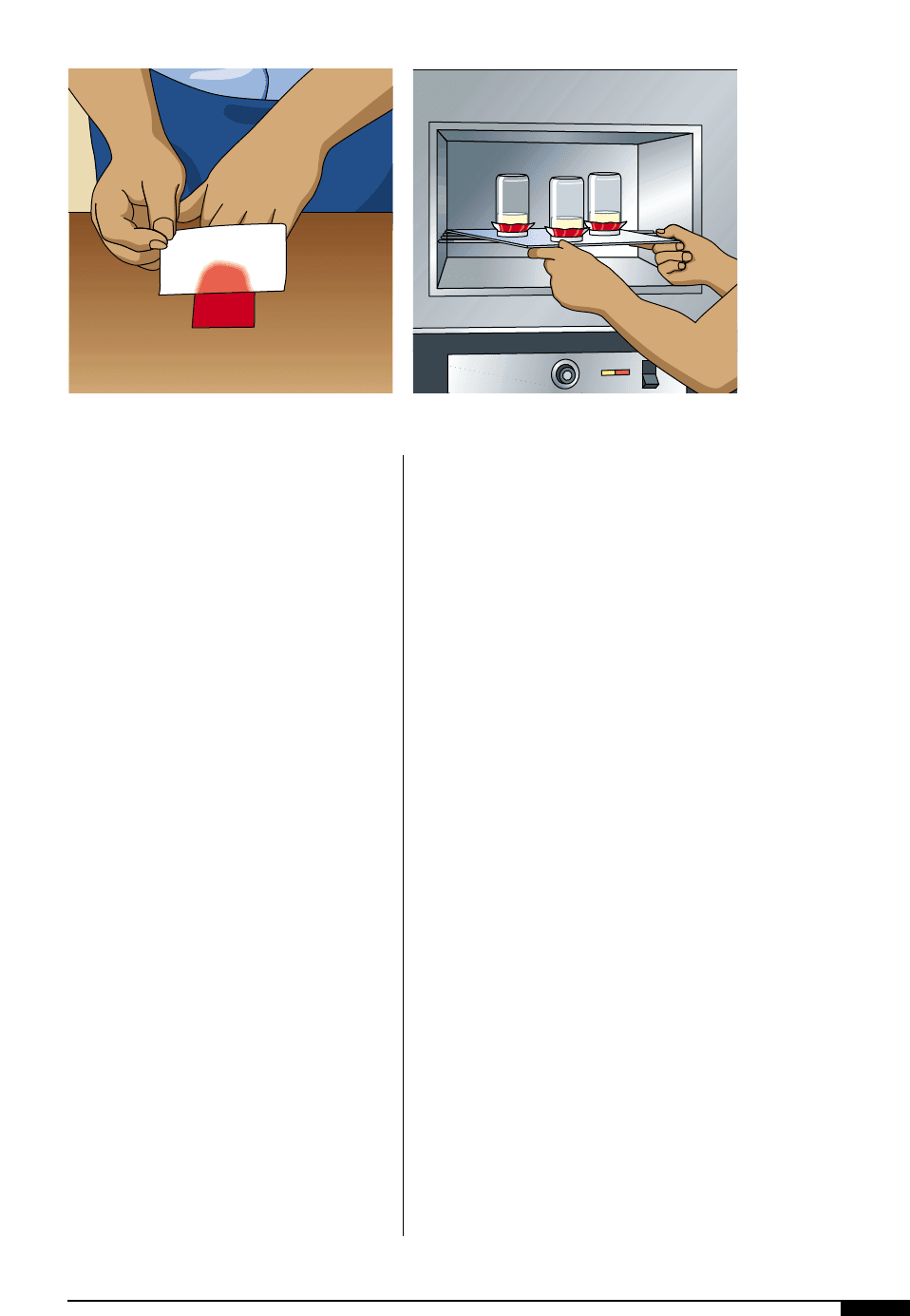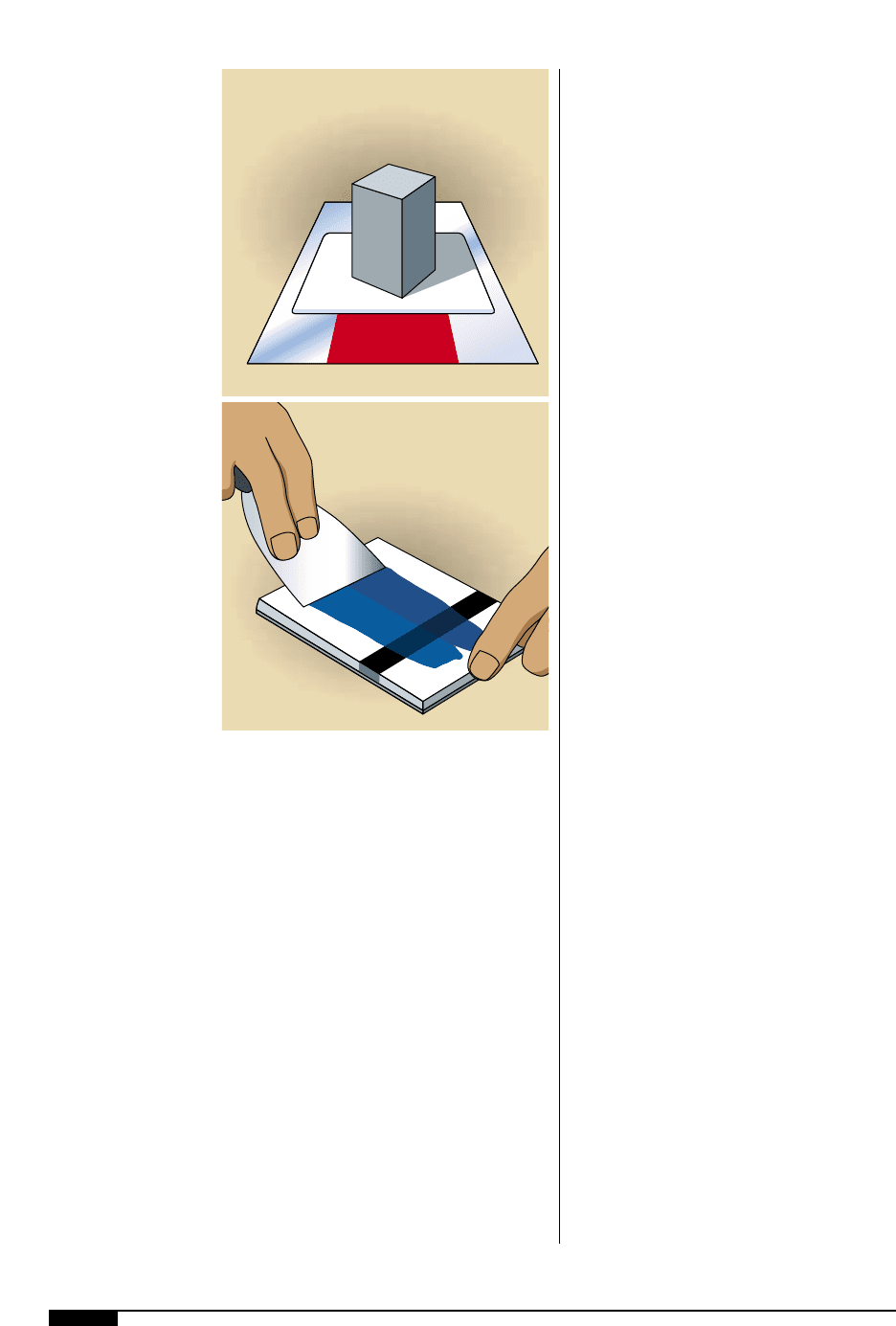FTA (изд-во). Flexography: Principles And Practices. Vol.1-6
Подождите немного. Документ загружается.


12 FLEXOGRAPHY: PRINCIPLES & PRACTICES
Transparent inks are often used for alu-
minum foil printing to enhance the brilliance
of the foil and produce an eye-appealing
effect.
Tags and Labels
Water-borne and UV flexo inks became
established in the tag and label market seg-
ment earlier than in the wide-web segment.
Initial testing was comparatively easy to
accomplish on narrow-web equipment and
the printing surface predominantly used was
friendlier to these inks. The tag and label
market continues to grow because, like plas-
tic packaging, these products are being used
increasingly as a marketing tool and lend
themselves to diversity and segmentation.
Rub resistance is more critical for the inks
used here because there are many more dif-
ferent substrates and conditions experi-
enced by labels than there are to packaging
products. This diversity often makes water
resistance more important because of the
use of labels in a wider range of applications
including shampoo, pharmaceutical and
soap pouches.
Chemical resistance is often necessary.
Pharmaceutical packaging, for example,
often must withstand isopropyl alcohol that
comes from exposure to a sterile environ-
ment (Figure
j
).
High gloss is another common require-
ment of printed label products, since they
usually involve surface rather than reverse
printing. This is usually accomplished with
UV coatings. Lightfast requirements are sim-
ilar to those of wide-web applications.
Household and
Office Paper Products
Household paper products, towels, tis-
sues, napkins and the like are almost exclu-
sively printed with aqueous flexo inks. They
are formulated for a wide range of absorbent
stocks. These inks must not bleed or rub off
in the presence of greasy foods and common
household cleansers. Tack, not normally
measured as a flexo ink property, must
remain low throughout the printing process
to prevent paper fiber and ink from plugging
the printing plate.
Other uses include decorative gift wraps,
ream wraps for copier paper, low-cost forms,
letterheads and envelopes. Many of these
applications do not require lightfastness. The
decorative papers use inks that offer bright
colors and special effects such as metallic or
fluorescent prints (Figure
1)
).
Publication/Commercial Printing
Water-based flexographic inks have
become a viable alternative in the newspa-
per market. The process has been identified
as an alternative to letterpress and offset
j
The tag and label
market is a growing
segment in flexography.
Like plastic packaging,
these products are
being used increasingly
as a marketing tool.
They lend themselves
to diversity and
segmentation.
1)
Flexography has also
found a niche in house-
hold and office paper
products, such as
printing envelopes
and letterhead.
j
1)

lithographic installations. Use has been
enhanced by advances in photopolymer
printing-plate technology and the ability to
satisfy the growing four-color needs of the
industry. Other cited advantages are elimina-
tion of VOCs, faster press speeds, reduced
costs and improved quality.
Over the years, the primary requirements
for newspaper inks were low cost and good
mileage because newsprint, a rough surface
that does not lend itself to quality work, is
generally used for printing copy that is read
once and then thrown away. Most newsprint
is printed with offset inks that dry by pene-
tration, which accounts for their low-rub
resistance. Heat-set inks are also available,
and give better printing results because they
are bound to the sheet after drying and do
not further penetrate the paper.
Flexography has also made inroads in
book and other publishing areas, such as
newspaper inserts and low-budget maga-
zines. Book printing is a specialized field
requiring different equipment and skills with
papers ranging from heavyweight coverstock
to very lightweight, almost tissue-thin paper.
As flexography expands in specific market
segments, it is finding applications in the
commercial printing, of anything from sim-
ple invitations to sophisticated brochures.
Print shops that flexography is employed in
range in scope from a simple one-press oper-
ation to a multifaceted business utilizing a
complicated maze of equipment.
TESTING END-USE
INK PROPERTIES
A number of tests have been established
over the years to evaluate the properties of
inks required for an increasingly broad spec-
trum of uses. They are described in detail in
reference material from the National Asso-
ciation of Printing Ink Manufacturers
(NAPIM), ANSI Standard Test Methods
(ASTM), the Flexographic Technical Asso-
ciation (FTA), and Technical Association of
the Pulp and Paper Industry (TAPPI).
Test procedures for some of the more
important properties are discussed here.
They fall generally into two categories: those
that test the durability of the ink film and
those that test its appearance. These tests
are not a complete list, but are offered as
guidelines for communicating ink require-
ments and demonstrating performance. The
most important criterion for any test proce-
dure is that it be performed consistently to
ensure that the manufacture of inks and
their subsequent application on press meet
the desired specifications and tolerances.
Substrate adhesion is most commonly mea-
sured using the pressure-sensitive tape adhe-
sion test, which compares the ink-to-sub-
strate bond to the bond of the adhesive
between tape and the ink surface.
To conduct the test, an 8" or wider sample
of the printed or coated substrate to be eval-
uated is placed on a flat surface and fastened
either mechanically with clamps or tape.
Sample tension should be sufficient to pre-
vent wrinkles and hold the sample flat
(Figure
1!
).
A 1" by 6" pressure-sensitive tape (3M 610
brand or equivalent) is applied full length to
the cross-direction width of the sample. Any
air bubbles are removed with one pass only
INK 13
1!
Substrate adhesion
is most commonly
measured using the
pressure-sensitive
tape adhesion test.
It compares the ink-to-
substrate bond to the
bond of the adhesive
between tape and ink
surface.
1!

14 FLEXOGRAPHY: PRINCIPLES & PRACTICES
of a rubber-covered roller, and then the tape
is immediately removed by pulling at an
angle of 180°.
The tape and substrate are examined for
evidence of adhesion failure. Adhesion is
reported as the estimated percentage of lift
on the substrate.
Crinkle adhesion determines the flexibility
and bonding characteristics of the ink when
a flexible substrate is crinkled. A piece of
the printed substrate is grasped between the
thumb and forefinger of each hand with
about 0.05" of substrate between the two
thumbs. The hands are brought almost
together and rotated fairly rapidly about 10
times (Figure
1@
). Avoid generating too
much heat or cutting into the print with the
fingernails. On coated substrates, it is nec-
essary to determine if the failure is ink adhe-
sion or coating separation.
Scratch resistance is determined by placing a
sheet of the printed substrate on a smooth,
resilient surface, a paper pad for example,
and scratching with the back of the index
fingernail. Fast “swipes” are made using
moderate pressure while avoiding cutting
the ink film (Figure
1#
).
Block resistance is the ability of a printed sur-
face to separate from an adjacent surface
without sticking or disturbing either. There
are a number of block tests. Figure
1$
shows
the “C” clamp press-side test generally used
to provide a quick, running indication of
whether thorough drying and complete sol-
vent removal is happening on the press. A
widely accepted block test is the IC block
test. Test samples are assembled in an IC
block tester and placed in an oven equipped
with automatic humidity and temperature
controls. This permits the testing of a series
of samples in "sandwich" form and provides
uniformly accurate results.
Lamination adhesion is critical for inks used
on a substrate designed to enhance barrier
and other property combinations, especially
those developed for packaging applications.
The inks do not need gloss or surface condi-
tioners, but they must have good adhesion to
the printed substrate and to the adhesive
1@
Crinkle adhesion
determines the
flexibility and bonding
characteristics of the
ink when a flexible
substrate is crinkled.
1#
Scratch resistance is
determined by placing
a sheet of the printed
substrate on a smooth,
resilient surface, a paper
pad for example, and
scratching with the
back of the index
fingernail.
1$
A “C” clamp, press-
side, block-resistance
test provides a quick,
running indication of
whether thorough
drying and complete
solvent removal is
happening on the press.
1@
1$
1#

materials. They must also withstand the tem-
perature of the lamination operation. Ink
tests for laminations are generally the same
as for single substrates. If the ink is on the
surface of the outer substrate, requirements
are the same as for surface-printed, single
substrates. If the ink is printed on one of the
inner substrate surfaces, though reverse-
printing of an outside transparent film, or
surface-printing of an inner substrate, it must
pass the pressure-sensitive tape test, the crin-
kle test for adhesion, and pressure block-
resistance test with the printed surface in
contact with the backside of the substrate.
Rub resistance is required of many printed
inks to enable the package to withstand han-
dling between the press and the point of
sale. Rub resistance may also be described
as resistance to scuff or abrasion. The
Sutherland rub test has been established as
the standard for measuring this property.
In a typical dry-rub procedure, a 7.5" test
strip (with a solid printed image l" by l.5" cen-
tered on the sample) is clipped to the four-
pound testing block (printed surface away
from the rubber pads). The printed sample is
mounted (print side up) on the rubber pad of
the base plate. The weight is placed over the
sample with one of the 1" by 2" test-block
rubber pads over the ink. Both surfaces
should be free of dirt. The tester should be
set for 100 strokes and, when the rubs have
been completed, both the inked surface and
the plain surface on the test block should be
examined for signs of transfer.
To measure wet-rub resistance, the test
strips are mounted in the same manner as
for dry rubs on the two-pound test block.
Two to six drops of water are placed on the
printed surface so that they will be covered
by the test block. The block is positioned
and press the test started. After one stroke,
both surfaces are examined for color trans-
fer. Individual strokes are repeated until ink
failure is noted. The number of strokes
required to cause failure is recorded.
Heat resistance is a companion requirement
to rub resistance in many printed packaging
applications and is needed to withstand the
heat applied by sealing equipment close to
the package. The heat sealing devices may
be the sliding, heated flat shoe or crimp-type
jaw designs. Sliding iron and crimp-seal tests
have been established to test required heat
resistance.
The sliding iron test (Figure
1%
) requires
that a hand iron is drawn at the desired tem-
perature (read with a surface pyrometer)
across the printed or lacquered surface a pre-
determined number of times, usually three.
After this, any breakdown of the ink or lac-
quer surface is noted, as is any drag on the
iron. Either of these results indicate unsatis-
factory heat resistance.
In the crimp seal test, either a laboratory
model or actual production crimp jaw on the
heat-seal equipment is set for correct tem-
perature, pressure and dwell time to dupli-
cate production requirements. The jaw tem-
perature required on high-speed automatic
packaging machines will be noticeably high-
er than the temperature to seal the heat-seal
substrate. The sample is sandwiched be-
tween aluminum foil or paper and placed
between the jaws of the heat sealer. The
crimp-sealing operation is repeated several
times on different areas of the substrate to
INK 15
1%
To test for heat
resistance on a printed
substrate, the sliding-
iron test requires that a
hand iron, set at a
certain temperature,
be drawn across the
printed surface a
pre-determined number
of times as any break-
down of the ink or
surface is noted.
1%

16 FLEXOGRAPHY: PRINCIPLES & PRACTICES
provide a more critical evaluation of ink
transfer. Results are acceptable, if there is
no cling or transfer of ink to foil. It helps to
operate the crimp jaw against a plain piece
of paper after the test. Any ink transfer or
sticking of the crimp jaws to the printed sub-
strate indicates unsatisfactory heat resis-
tance or ink flexibility.
In some applications, the printed area
must heat seal to itself or to an unprinted
surface. Heat sealing can be tested with
either the sliding iron or the crimp seal jaws.
The heat seal is pulled by hand or on a seal
puller that gives a numerical rating and com-
pares seal strength to that known to be
acceptable.
Ice-water crinkle test checks the flexibility and
integral strength of a print subjected to ice,
refrigerator or freezer conditions. Samples
are immersed in a beaker of water and
cracked ice for 30 minutes and then
removed. While they are still wet, the sam-
ples are grasped firmly between thumb and
forefinger of each hand with about 1" of print
between the two thumbs. With the hands
together, the samples are rubbed 10 times
rapidly in opposite directions. One complete
cycle consists of both a back and forward
motion of the wrists. The percentage of ink
removed is recorded and compared to the
standard (Figure
1^
).
To test for freeze-thaw resistance, the printed
samples are immersed in a beaker of water
and put in a freezer for 16 hours. After
removal, the beaker is allowed to thaw to
normal room temperature and then the sam-
ples are given the crinkle test.
Moisture bleed or transfer resistance test is
important for packages that come out of the
freezer and sit on the kitchen counter to
thaw. The printed ink should not bleed onto
the counter as moisture condenses on the
cold package. Using the Sutherland rub test,
a strip of blotting paper 5.5" by 2" is mounted
on the test block with the felt or smooth side
out. The blotter is saturated with water. The
wet blotter is placed on the sample to be test-
ed and left in place for four minutes. The
block is removed without rubbing and exam-
ined for ink transfer to the blotter. An alter-
native procedure is to place the print sample
in a beaker of water for 24 hours. The sample
is then removed and wiped with a white tis-
sue. Both the tissue and the water in the
beaker are inspected for any color bleed.
Moisture vapor transmission resistance test
protects packaged products such as cookies
and snacks from the humidity of the sur-
rounding atmosphere. Instruments are avail-
able to measure the moisture vapor trans-
mission rate (MVTR) of printed packaging
materials. Such units automatically record
1^
The ice-water crinkle
test checks the flexibility
and integral strength of
a print subjected to ice,
refrigerator or freezer
conditions.
1&
Acid and alkali
resistance is tested by
applying a drop of the
appropriate reagent to
the sample print. After
a few moments, it is
allowed to run off the
printed area onto the
unprinted section.
The print area is gently
scratched to observe if
the ink vehicle has been
affected.
1^ 1&

the time required for moisture to pass
through the test sample. Results are reported
in grams per 100 square inches per 24 hours.
Acid and alkali resistance is required of print-
ed ink films that come in contact with dairy
products, juices, and other products that
contain acids. To test, a drop or two of the
appropriate reagent is applied to the sample
print (Figure
1&
). After a few moments, it is
allowed to run off the printed area onto the
unprinted section where any dissolved color
can be seen. The print area is gently
scratched to observe if the ink vehicle has
been affected.
Soap and detergent resistance is essential for
the many flexo-printed materials used to
package and label soaps, detergents, flakes,
and granules. One method of testing is to
pour 10 cc of a concentrated solution of
soap or detergent in water on a 4" by 4" fold-
ed, unbleached and unsized muslin pad
(Figure
1*
). A test print of 3" by 3" or larger
size is placed face up on a smooth glass plate,
and the muslin pad is placed on the print.
Over the pad is placed a flat 12-ounce
machined plate, which is left for a period of
time determined by the product and stock
specifications. The sample is then examined
and graded according to the amount of dis-
coloration on the surface of the muslin and
the change in appearance of the test print.
Similar practical tests have been devised to
determine the resistance of ink formulations
to smudging with soap or detergent pastes
and to soaps in bar or cake form.
Oil resistance is necessary for inks that come
in contact either directly or indirectly with
packaged foods containing oil naturally or as
a process additive. To determine resistance
to oils that may penetrate the substrate,
about 1" of the product oil is put into a wide
mouth fruit jar. The printed sample is placed
on top of the jar with the printed surface up
(or down with impervious films) and the jar
is sealed with an open-top ring jar closure.
The sample is inverted on a glass tray and
placed in an oven for 48 hours at 1,200° F
(490° C) and 90% humidity (Figure
1(
). At
the end of the cycle, the printed surface is
checked for adhesion by both the pressure-
sensitive tape and crinkle tests.
Boiling water resistance is needed for printed
convenience food packages in which food is
heated before serving. For a typical boiling
water test, the printed sample is cut into
strips and placed in 200 ml. of boiling water
for 5 minutes. The printed strips and water
are examined for evidence of bleed or dis-
coloration which connotes ink failure. For
steam resistance needed in sterilization and
food processing applications, tests are run in
equipment ranging from household pressure
INK 17
1*
To test for a substrate’s
soap and detergent
resistance, a small
sample of printed sub-
strate is placed on top
of an unbleached and
unsized muslin pad that
has been saturated with
a concentrated soap or
detergent solution.
Pressure is applied to
the pad and print for a
length of time. The sam-
ple is then examined
and graded according
to the amount of discol-
oration on the surface of
the muslin.
1(
To determine a sub-
strate’s oil resistance,
the product oil and the
print sample is put into
a wide-mouth mason
jar. The sample is
inverted on a glass tray
and placed in an oven at
controlled temperature
and humidity for the
specified time.
1* 1(

18 FLEXOGRAPHY: PRINCIPLES & PRACTICES
cookers to autoclaves at temperatures from
2,150° to 4,000° F (1,020° to 2,040° C). Prints
are then inspected for bleed, discoloration
and ink breakdown.
Plasticizer bleed resistance test becomes
important for printing films such as vinyl
that contain plasticizers. Plasticizers can
cause inks to bleed into the film or onto
another material in contact with the ink. A
commonly used test procedure is to saturate
a piece of white-blotter stock with plasticiz-
er and place it on the test print (Figure
2)
).
A light weight is put on the sandwich, which
is then placed in an oven at controlled tem-
perature and humidity for the specified time.
The blotter is examined for plasticizer stain.
Properties that ensure good ink appearance
are equally important as those that con-
tribute to an ink film’s durability. They
include aspects of color (hue match, intensi-
ty and value) density, tone quality, image
detail, opacity, fade resistance and gloss.
Color measurements are still commonly per-
formed with the naked eye, which remains
one of the most sensitive judges of color and
its variations. Visual color judgments should
be made under standard viewing conditions
such as the American National Standards
Institute PH2-30-1989 viewing standard.
Production prints should be compared to the
color standard on the substrate on which the
ink will be printed. Comparisons of wet inks
can be made by draw-downs (Figure
2!
) in
which an ink drop is spread over a substrate
with a rigid blade or block of steel or by
anilox proof in which the rollout is made
with an anilox hand proofer.
Color measurements can also be taken
using colorimeters and spectrophotometers
(Figure
2@
) which offer consistent and mea-
surable results. These instruments allow
operators to monitor production control,
color difference calculations, color specifi-
cation and tolerance tasks. Measurements
should be performed at the instrument’s
largest viewport area possible. Two samples
each from the front, middle and end of the
pressrun, on both sides of the sheet, and for
each color, should be measured. Readings of
solid-ink densities at several areas of speci-
men surface should be taken to obtain an
indication of uniformity and an average ink-
density value.
Print density can be measured with a reflec-
tion densitometer. The instrument must be
calibrated before testing. The LO (white stan-
dard) and HI (black standard) values for
each color are set and then individual color
patches are read as determined by the instru-
ment. Calibration values are verified for each
standard patch and adjustments made as
necessary. Two substrate samples each from
the front, middle, and end of the press run
are taken. Readings at 10 locations on each
2)
Plasticizer bleed-resis-
tance test procedure
requires saturating a
piece of white-blotter
stock with plasticizer
and placing it on the
test print . A light
weight is put on the
sandwich, which is then
placed in an oven at
controlled temperature
and humidity for the
specified time. The
blotter is examined for
plasticizer stain.
2!
Color measurements
can be taken by
comparing wet inks
done with draw-downs,
where an ink drop is
spread over a substrate
with a rigid blade, block
of steel or by anilox
proof and the rollout is
made with an anilox
hand proofer.
2!
2)

sample for each of the colors, in solid ink-
density areas.
Tone quality can be determined by measuring
dot area (percentage of ink coverage on the
substrate) with a reflection densitometer.
Two samples each from the front, middle
and end of the pressrun for each substrate
are tested for all colors for each sample. The
instrument must be calibrated before test-
ing. The dot area function is selected and the
densities of both the substrate and the per-
cent solid are read to obtain the dot area
percentage. Readings are taken at five ran-
dom spots from each sample color and aver-
aged to obtain the dot area percentage for
the sample.
Image detail can be checked using a digital-
frame grabber equipped with high resolution
optics and a personal computer equipped
with image analysis software to quantify the
following dot characteristics: maximum and
minimum dot area, concentricity, maximum
and minimum diameter and density profile.
At least 50 dots are measured per sample
and readings are taken from five random
spots of each sample color. Measurements
can also be made using a densitometer.
Opacity or contrast ratio can be measured using
a spectrophotometer. The ink sample is print-
ed using an appropriate technique, on a black
line sheet. The sample is measured on both
the white and black portions of the substrate.
The system will then calculate the contrast
ratio or approximate opacity of the film.
Fade resistance requirements will depend on
the application. Inks on an outside billboard,
for example, will require much more fade
resistance than those on a grocery product
with a short shelf life. Rough comparisons
are made by covering a portion of each sam-
ple with an opaque material. The samples are
exposed to sunlight. Equipment such as the
Fadeometer or Weatherometer can be used
to conduct accelerated light-fading tests.
Gloss of a finished print can be normally
judged visually, but instrument readings can
be obtained with a gloss meter (60° angle)
and some spectrophotometers to determine
the specular gloss of the material surface.
Tile standards are cleaned and the instru-
ment is calibrated according to instructions.
Measurements are taken of two samples
each from the front, middle and end of the
run. Reading areas should be consistent in
ink coverage or solid ink densities. The read-
ings should be repeated for all colors,
recorded and averaged.
Coefficient of friction (COF) properties indicate
the ease or resistance of a surface to move or
slide against another surface, and are impor-
tant both to successful production processes,
such as automatic packaging operations, and
to applications such as skid resistance of
stacks of multiwall bags. To determine the
INK 19
2@
Color measurements
can be taken using
colorimeters and
spectrophotometers,
which offer consistent
and measurable results.
2#
To determine the
resistance to sliding
of a printed sample,
the substrate is
attached, face up,
to the end of the inclin-
able arm of a plane.
A second piece is
attached to a weight
positioned at the right
end of the arm. The arm
is inclined slowly and
steadily. At the point
where the weight block
begins to move down
the incline, the angle is
read on the protractor
scale.
2@
2#

20 FLEXOGRAPHY: PRINCIPLES & PRACTICES
resistance to sliding of a printed sample, a
strip of plain or printed substrate is attached,
face up, to the end of the inclinable arm of the
plane. A second piece is attached to the stan-
dard weight which is positioned at the right
end of the arm. The arm is inclined slowly and
steadily. At the point where the weight block
begins to move down the incline, the angle is
read on the protractor scale (Figure
2#
). A
more accurate measurement of coefficient of
friction uses an IBM friction coefficient tester
to provide numerical values for both static
and kinetic COF. The instrument applies force
to test strips (one clamped to the unit, one
free to move) and calculates slip characteris-
tics (Figure
2$
).
Odor, or absence thereof, is particularly
important in food and personal product pack-
aging applications. To test, the printed speci-
men is placed in a jar, sealed with a cap and
then placed in an oven at 1,000° F (380° C)
for 2 hours. The steps are repeated for
unprinted control substrate. The jar is opened
and a qualitative assessment of the odor is
recorded.
2$
A friction coefficient
tester takes measure-
ments of both static and
kinetic COF. At the same
time, it also calculates
the slip resistance.
2$

INK 21
Ink Formulation
H
aving identified and specified
the end-use requirements for
the printed package and
understood the converting
conditions, the ink supplier is
in a position to formulate an
ink system to meet the needs of the job.
These end-use requirements, as discussed in
the first chapter, can impose limits on the
materials available for use by the ink formu-
lator. Therefore, it is necessary for the for-
mulator to have a comprehensive under-
standing of the physical properties of the
raw materials used to produce inks, their
interactions and their limitations in produc-
ing a usable ink. The converter and end-user
must possess similar knowledge.
Printing inks are colored media designed
to reproduce an image on a printing surface.
They are primarily used to convey a mes-
sage, provide protection, or give a decora-
tive effect to the material on which they are
applied. Inks are extremely versatile and
have been used on a wide variety of papers,
plastics, metals, glass and textile surfaces.
The majority of printing inks consist of a col-
orant, either an insoluble solid or dye, sus-
pended or dissolved in a liquid vehicle. The
resulting combination forms a colored fluid
capable of distribution and transfer on a
printing press.
In addition to providing the desired visual
characteristics, inks are formulated to meet
the specific needs of the printing process:
they must dry under specified conditions;
adhere to a given material; and have specific
resistance properties, dictated by the inter-
mediate processing and the final end-use of
the finished product.
Inks for flexography have two prominent
characteristics that set them apart from inks
used in most other printing processes: they
are fluid and quick drying.
THE BASICS OF INK TECHNOLOGY
This section will explore these aforemen-
tioned requirements and the impact that the
individual components and other con-
stituents have on flexographic ink manufac-
turing, print properties, performance, and
the environment.
Color
Sir Isaac Newton, using a glass prism,
demonstrated that white light could be split
up into a “rainbow” of hues: red, orange, yel-
low, green, blue and violet, which he called
the visible spectrum. Newton also observed
that the rays themselves are not colored, but,
when they interact with an object, that the
sensation we refer to as color is perceived.
With very few exceptions, objects do not
emit colored light, but only look colored
when under illumination. An object that
appears black under standard illumination
does so because it absorbs all the light
falling onto it. Conversely, an object which
appears white under the same lighting con-
ditions looks as it does because it reflects all
the light incident upon it. If the object
absorbs some portions of this “standard”
spectrum more than others, it will appear
colored. For example, an object that absorbs
only red light will appear cyan.
It is important to note that the colors per-
ceived depend on the illuminating source.
Different sources of light, e.g., incandescent,
